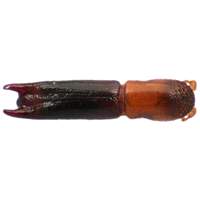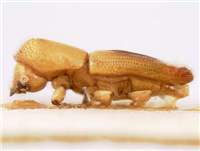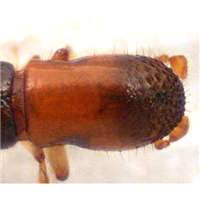Diagnosis
Slender species, mostly minute but some species long and large. Two key characters: pronotum extremely elongated, constricted laterally; declivity emarginate, with a pair of sulci or projections, one on apex of each elytron.
Distribution
Small and fragile species occur infrequently in tropical Asia and Oceania. Larger, more robust species mostly reported from South Asia and Africa.
Biology
Gallery consists of several short, often parallel tunnels (Browne 1961).
Taxonomy
Genus resurrected from synonymy with Coptoborus and re-described by Hulcr et al. (2007).
Detailed description
Eyes shallowly emarginate, upper part smaller than lower part. Antennal club approximately circular, or taller than wide, club type two (obliquely truncated, segment 2 visible on posterior side). Segment 1 of club dominant, its margin costate to soft, pubescent. Segment 2 visible on both sides of club, but soft, or corneous part on anterior side only. Segment 3 absent from posterior side of club. Segment 1 of antennal funicle shorter than pedicel, funicle 4-segmented, scapus regularly thick. Frons above epistoma smooth, alutaceous, with minor punctures. Submentum flat, flush with genae, shaped as very narrow triangle. Anterior edge of pronotum with short continuous elevated carina. Pronotum from lateral view long, "hooded" frontally (type A), from dorsal view long and rounded anteriad (type 9), or long and conical anteriad (type B). Pronotal disc shining or smoothly alutaceous, with small punctures, lateral edge of pronotum concave. Procoxae contiguous, prosternal posterocoxal process short, conical. Tuft on pronotal basis associated with mesonotal mycangium absent, setae on elytral bases associated with elytral mycangium also absent. Scutellum miniature but visible, or flat, flush with elytra. Elytral bases straight, with oblique edge, elytral disc longer than declivity, flat, punctures on elytral disc in strial lines (which may be difficult to discern). Boundary between elytral disc and declivity indistinct, flat or slightly convex disc transitions smoothly into flat declivity. Lateral profile of elytral declivity slowly descending, flat, dorsal profile of elytral apex emarginate. Elytral declivity with no pubescence. Posterolateral declivital costa absent or undefinable. Surface of declivity devoid of tubercles. All species have a pair of elongated processes on elytral lateral apices. First interstriae parallel, or parallel on disc but broadened towards apex of elytra. Protibiae very slender, slightly broader only at distal end. Posterior side of protibia flat. Protibial denticles large, distinctly longer than wide, bases of denticles not enlarged or slightly enlarged, fewer than 6 protibial denticles present. Metatibiae of normal size. Color variable, mostly very light, yellow or light brown, or pronotum much lighter (yellow or orange) than elytra. Some of the smallest and most slender Xyleborini, species in New Guinea around 2 mm.



